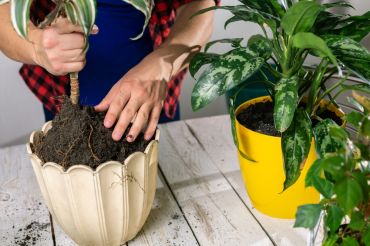
Here is how to repot a container plant perfectly to ensure it settles in well and thrives. When it is time to repot, which could be for various reasons, it is straightforward with just a few steps to ensure your plant doesn’t get damaged and is in the right size pot with good quality compost suitable for your specific plant.
How to Repot a Container Plant That Is Root Bound
Usually, the time you realize your plant needs repotting is because you have noticed it struggling and, on inspection, found it to be root bound. Some plants quite enjoy being root-bound, but the majority need space for their roots to expand and for the plant to thrive. Place the plant pot onto its side and gently tease out the root ball by manipulating the pot's outside and gently tapping the bottom. If it is particularly tight, you might need to cut the pot with a sharp pair of scissors.
In your new pot, place good quality compost and put the old pot in the middle, making a hole the size of the rootball, then all you need to do is put your plant directly into the perfectly sized space, cover it over with a little more compost and water in well. It can help to tease the roots a little before planting.
How to Repot a Container Plant With Other Plants
If you have a container display and want to squeeze one more plant in, it’s the best time to replenish the soil and have a shuffle around.
- Gently remove the plant from its pot as above, and if any of the plants need moving in the container it is being moved to, now is the time to do the same with them.
- Add some plant food and/or new compost and make the perfect space for your new plant in the display.
How to Repot a Container Plant for Indoors
If you need to repot a houseplant, the same applies mostly as above. Houseplants can very quickly grow big enough to need a new pot, so we always recommend having some spare so you can get the job done as soon as needed. Ideally, pot them up when they are in active growth rather than over the winter months, and you can pot them just as above, but ensure you are using a houseplant compost with great drainage. Special compost is also available for cacti and succulents.
Remember to water and feed your repotted plants to help them settle in and thrive. Also, prune and deadhead, remove all damaged or diseased material.
For pots, compost, and plants for your home and garden, visit us in store.




